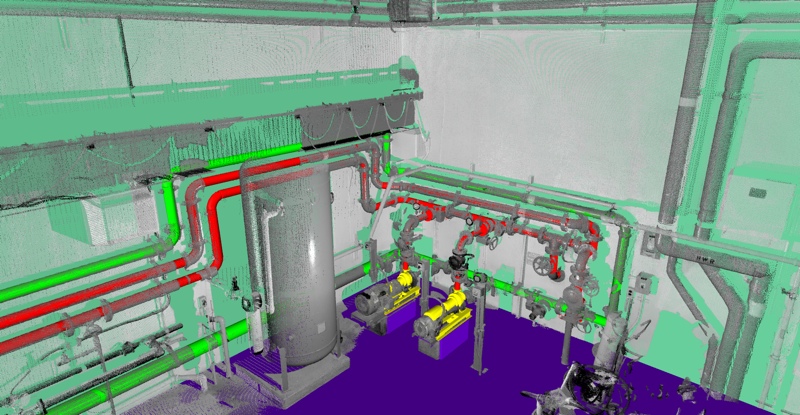Last week Grand Rapids, Michigan-based mechanical contractor and fabricator Andy J. Egan announced its newest acquisition: 3D Imaging Services (3DIS), a “construction technology company that specializes in providing digital documentation utilizing advanced 3D imaging technologies, as-built modeling, facilities management solutions and more.”
Yesterday, I caught up with Andy Jasper, president of Andy Egan, and Michael James, Project Director with 3DIS. We talked about why a contractor of this size, founded in 1919, decided to take the leap and bring 3D scanning services in-house.
Roots in 3D BIM
Andy Egan may be nearly a century old, but it has often been on the forefront of the technology adoption cycle. For instance, as early as 2001, the firm implemented 3D building information modeling (BIM). That decision changed their workflow for the better.
“Way back, about 15 or 16 years ago,” Andy Jasper told me, “we started doing fabrication in-house, and we saw that 3D BIM was a perfect feed into our fabrication shop. So we started BIM for the sole purpose of supporting our own fabrication.”
That implementation allowed Andy Egan to save money and time by performing the fabrication for their construction projects offsite. After that, it was a matter of transporting the pipes to the site and installing them in the mechanical room or boiler room.
Beyond Clash Detection
This decision had another effect on Andy Egan: It started a change in company culture to incorporate 3D technologies holistically into the firm’s work.
“We at Andy Egan have long said that you don’t just buy technology,” said Beth Jester, a marketer with the firm. “You don’t just acquire a 3D-imaging company and say ‘now we do this.’ We are firm believers that you have to spend the time to implement those processes amongst all tradespeople. As a cultural shift it was hard, and that’s why we warn people that you can’t just go out and buy this.”
However challenging it was for Andy Egan to change its culture, this work has helped set the groundwork for realizing the full benefits of 3D technologies. That means performing work much more complex and beneficial than simple clash detection and offsite fabrication.
“Andy Egan’s sophistication in taking and coordinating BIMs and sending that to fabrication was phase one,” said Michael James. “Getting more advanced and actually documenting these systems in a facility accurately, quickly, and getting it into a 3D environment so BIM coordination efforts could take place, they had to complete that circle.”
The Downstream Value of 3D
As Andy Egan began using 3D laser scanning in their projects, they contracted with 3DIS, who quickly became the preferred vendor. Seeing a similarity in their approaches to construction technology, the two companies struck a deal. “With 3DIS, because we’ve been working together so long, it was a part of the culture already,” said Jester. “It’s become an extension of what we do.”
This holistic incorporation of 3D technologies with Andy Egan’s other services has a number of downstream financial benefits that may not be obvious immediately.
Michael James explained that the proper coordination of 3D technologies up front “trickles down to cost savings in the field, into construction, in the things on the back end that people just starting today don’t really realize. They look at scanning as an up-front cost. They don’t see where the value, where the savings are.”
Areas of savings include increased efficiency, better coordinated workflows, and reduced material costs. When all the work is performed in-house, the challenges of coordination are reduced. And there’s one more benefit: customer retention.
“Andy Egan is hoping that this will give us a first shot at future construction opportunities by getting us involved earlier” said Andy Jasper. “With scanning, some owners will see that as a natural transition into the construction relationship.”
Michael James explained that scanning companies like 3DIS “will get involved so much earlier on jobs than the main engineering firms, before construction firms or general contractors have even been thought about. This will help get our company, Egan 3DIS, involved very early.”
Which means, as usual, the biggest value of bringing 3D scanning in-house is the benefit that all companies are looking for: competitive edge.
For more on why 3DIS decided to come into the Andy Egan organization, read SPAR 3D’s coverage.






